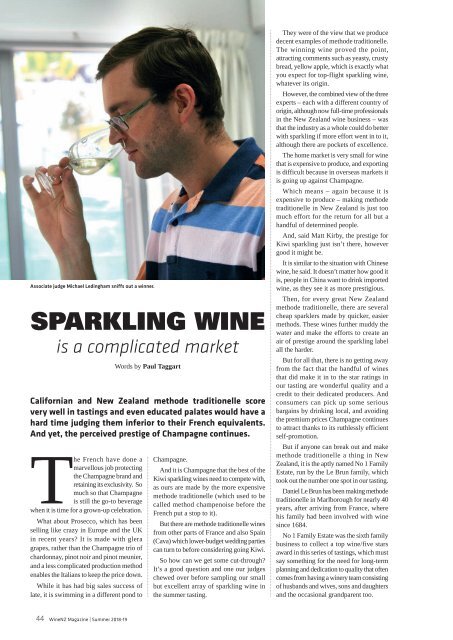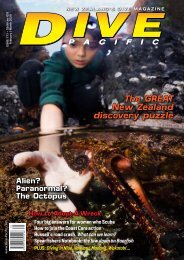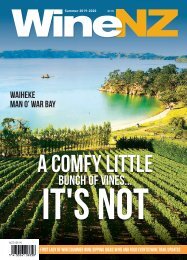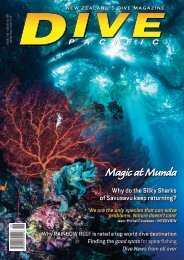WineNZ Summer 18-19 (1)
Create successful ePaper yourself
Turn your PDF publications into a flip-book with our unique Google optimized e-Paper software.
Associate judge Michael Ledingham sniffs out a winner.<br />
SPARKLING WINE<br />
is a complicated market<br />
The French have done a<br />
marvellous job protecting<br />
the Champagne brand and<br />
retaining its exclusivity. So<br />
much so that Champagne<br />
is still the go-to beverage<br />
when it is time for a grown-up celebration.<br />
What about Prosecco, which has been<br />
selling like crazy in Europe and the UK<br />
in recent years? It is made with glera<br />
grapes, rather than the Champagne trio of<br />
chardonnay, pinot noir and pinot meunier,<br />
and a less complicated production method<br />
enables the Italians to keep the price down.<br />
While it has had big sales success of<br />
late, it is swimming in a different pond to<br />
Words by Paul Taggart<br />
Californian and New Zealand methode traditionelle score<br />
very well in tastings and even educated palates would have a<br />
hard time judging them inferior to their French equivalents.<br />
And yet, the perceived prestige of Champagne continues.<br />
Champagne.<br />
And it is Champagne that the best of the<br />
Kiwi sparkling wines need to compete with,<br />
as ours are made by the more expensive<br />
methode traditionelle (which used to be<br />
called method champenoise before the<br />
French put a stop to it).<br />
But there are methode traditionelle wines<br />
from other parts of France and also Spain<br />
(Cava) which lower-budget wedding parties<br />
can turn to before considering going Kiwi.<br />
So how can we get some cut-through?<br />
It’s a good question and one our judges<br />
chewed over before sampling our small<br />
but excellent array of sparkling wine in<br />
the summer tasting.<br />
They were of the view that we produce<br />
decent examples of methode traditionelle.<br />
The winning wine proved the point,<br />
attracting comments such as yeasty, crusty<br />
bread, yellow apple, which is exactly what<br />
you expect for top-flight sparkling wine,<br />
whatever its origin.<br />
However, the combined view of the three<br />
experts – each with a different country of<br />
origin, although now full-time professionals<br />
in the New Zealand wine business – was<br />
that the industry as a whole could do better<br />
with sparkling if more effort went in to it,<br />
although there are pockets of excellence.<br />
The home market is very small for wine<br />
that is expensive to produce, and exporting<br />
is difficult because in overseas markets it<br />
is going up against Champagne.<br />
Which means – again because it is<br />
expensive to produce – making methode<br />
traditionelle in New Zealand is just too<br />
much effort for the return for all but a<br />
handful of determined people.<br />
And, said Matt Kirby, the prestige for<br />
Kiwi sparkling just isn’t there, however<br />
good it might be.<br />
It is similar to the situation with Chinese<br />
wine, he said. It doesn’t matter how good it<br />
is, people in China want to drink imported<br />
wine, as they see it as more prestigious.<br />
Then, for every great New Zealand<br />
methode traditionelle, there are several<br />
cheap sparklers made by quicker, easier<br />
methods. These wines further muddy the<br />
water and make the efforts to create an<br />
air of prestige around the sparkling label<br />
all the harder.<br />
But for all that, there is no getting away<br />
from the fact that the handful of wines<br />
that did make it in to the star ratings in<br />
our tasting are wonderful quality and a<br />
credit to their dedicated producers. And<br />
consumers can pick up some serious<br />
bargains by drinking local, and avoiding<br />
the premium prices Champagne continues<br />
to attract thanks to its ruthlessly efficient<br />
self-promotion.<br />
But if anyone can break out and make<br />
methode traditionelle a thing in New<br />
Zealand, it is the aptly named No 1 Family<br />
Estate, run by the Le Brun family, which<br />
took out the number one spot in our tasting.<br />
Daniel Le Brun has been making methode<br />
traditionelle in Marlborough for nearly 40<br />
years, after arriving from France, where<br />
his family had been involved with wine<br />
since 1684.<br />
No 1 Family Estate was the sixth family<br />
business to collect a top wine/five stars<br />
award in this series of tastings, which must<br />
say something for the need for long-term<br />
planning and dedication to quality that often<br />
comes from having a winery team consisting<br />
of husbands and wives, sons and daughters<br />
and the occasional grandparent too.<br />
44 <strong>WineNZ</strong> Magazine | <strong>Summer</strong> 20<strong>18</strong>-<strong>19</strong>













